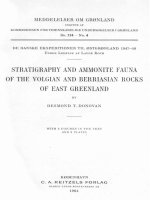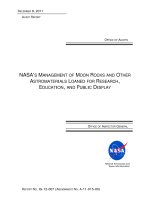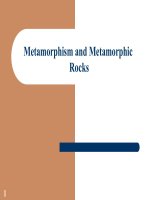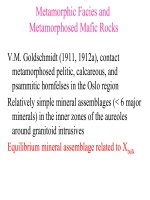Metamorphic rocks
Bạn đang xem bản rút gọn của tài liệu. Xem và tải ngay bản đầy đủ của tài liệu tại đây (504.2 KB, 26 trang )
Metamorphic Rocks:
• Meta = change
Morph = form
• Metamorphic rocks form from changes to preexisting rock caused by heat and pressure
• Metamorphism can occur locally over a small area,
or over a large area covering many kilometers
Two Types of Metamorphism...
• Regional Metamorphism - heat and pressure are
significant over a wide area (many kilometers)
• Contact Metamorphism - occurs over a small area
when pre-existing rocks come into contact with hot
liquid magma from an igneous intrusion.
Metamorphic Rocks...
• Classified on the basis of type of metamorphism
(Regional or Contact) and texture:
– Foliated (occurs w/regional metamorphism)
– Non-foliated (usually occurs w/ contact metamorphism)
Regional Metamorphism
• Changes to rock over a large area
• Layers of rock deep in the Earth’s crust experience the
following:
– 1. High temperatures (depth and friction)
– 2. High pressures (weight and crustal movement)
– 3. Exposure to hot liquids, water, and gases
• Results:
– Mineral grains are compressed
– minerals “migrate” through rock and begin to separate
– minerals are aligned within rock in response to
pressures to produce foliation
Regional Metamorphism...
• Foliation - the alignment of minerals within a
rock caused by heat and pressure
This sample is
clearly foliated.
see the mineral
alignment???
Draw the foliation that results from regional
metamorphism
BEFORE
AFTER
Metamorphic Grade (degree of metamorphism)
Sedimentary
Rock
Low-Grade
Metamorphic
Rock
MediumGrade
Metamorphic
Rock
MediumGrade
Metamorphic
Rock
HIGH-Grade
Metamorphic
Rock
SHALE
SLATE
PHYLLITE
SCHIST
GNEISS
Clay minerals,
stratified, soft, and
fragile, dull in
appearance
Harder,
microscopic mica
minerals begin to
form, less air space;
dull shine
Micas still
Visible mica grains;
microscopic, but
foliation obvious;
begin to reflect
other minerals may
more light; “silky”
be seen.
sheen in appearance
Clearly “banded”
appearance as
minerals separate
into alternating
bands
This nice piece of
schist has large,
visible garnet crystals
in it.
This sample of schist
shows mica minerals
that have grown
large enough to
reflect light.
Here is another gneiss which shows distinct banding due to
mineral alignment. The arrows indicate how this sample
was squeezed by pressure at great depth below ground.
Contact Metamorphism
• Occurs over as small area around magma (igneous
bodies)
– country rock (pre-existing, in-place) is baked by the hot
temperatures associated with magma
– hot liquids and gases mix with country rock
• Results:
– minerals migrate and fuse together
– no foliation or alignment since pressure is not significant
Contact metamorphism
has occurred around this
igneous intrusion.
Draw layers of rock getting metamorphosed by
coming into contact with magma
Metamorphism – Parent Rock Definition
• Parent Rock - the pre-existing rock from which a
metamorphic rock forms
Metamorphism
Sedimentary
Material
Sedimentary
Rock
Metamorphic
Rock
Pebbles, gravel, sand
Conglomerate
Quartzite, Gneiss
Sand Grains (usually
quartz)
Sandstone
Quartzite
Clay (usually kaolin),
Silt
Shale, Mudstone
Slate, Phyllite,
Hornfels, Schist
Lime (shells,
fragments, grains)
Limestone
Marble
Metamorphic Rock Quiz...
• Metamorphic Rocks form from changes to other
rocks in response to pressure and heat
• TRUE
Metamorphic Rock Quiz...
• Metamorphic rocks are classified by their mineral
composition primarily
• FALSE. Metamorphic rocks are classified on the
basis of texture and type of metamorphism
Metamorphic Rock Quiz...
• Foliation in metamorphic rocks is the alignment of
minerals in response to high temperatures along
with great pressure.
• TRUE!
Metamorphic Rock Quiz...
• Only contact metamorphic rocks experience
foliation.
• FALSE. Regional metamorphic rocks become
foliated due to high pressure in addition to high
temperatures
Metamorphic Rock Quiz...
• Shale is a low-grade metamorphic rock
• FALSE. Shale is a sedimentary rock.
Metamorphic Rock Quiz...
• Middle to high grade metamorphic rocks appear
shiny because as mica minerals crystallize they
begin to reflect light.
• TRUE!
Metamorphic Rock Quiz...
• Extremely high grade metamorphic rocks
experience more alignment of minerals into distinct
bands.
• TRUE.
Metamorphic Rock Quiz...
• Rocks that come into contact with an igneous
intrusion will only change into igneous rocks.
• FALSE. The high heat near an igneous intrusion
will “burn” the surrounding rock and change it into
metamorphic rock.
Metamorphic Rock Quiz...
• The pre-existing rock that was changed into a
metamorphic rock is called the “Grandma” rock.
• FALSE. The original rock is called the parent rock.









